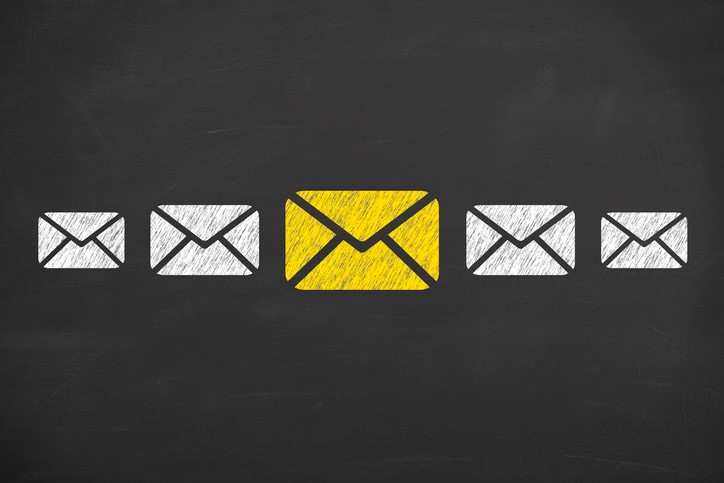 When email marketing began around 1978, its low cost, speedy delivery, and great response rates made marketers wonder if direct mail would disappear forever.
When email marketing began around 1978, its low cost, speedy delivery, and great response rates made marketers wonder if direct mail would disappear forever.
Today, that couldn’t be further from the truth. An overload of digital messages has caused open and click-through rates to decline substantially, and many spam filters and firewalls block emails altogether.
At the same time, a volume decrease in traditional mail has allowed direct mail marketing to rise to the top of the mailbox, being noticed, read, and responded to more frequently.
Need proof? Here are some stats to consider:
- According to the Direct Marketing Association’s 2017 Response Rate Report, direct mail offered a 5.1 percent response to house lists and a 2.9 percent response to rented lists across all direct mail formats. (In comparison, the 2017 response rate for all digital channels combined was 2 percent.)
- Eighty-five percent of consumers will open a piece of mail that catches their attention, and more than 40 percent of recipients read the entire piece.
- Ninety-two percent of Millennials are persuaded to make a purchase decision based on direct mail as opposed to 78 percent who are influenced to purchase through email marketing. Sixty-three percent of these direct mail responders said they had made a purchase in the last three months.
- Consumers of all ages are 22 percent more likely to purchase products promoted through direct mail than they are products advertised through email.
- Eighty-two percent of Millennials say they read direct mail they get from retail brands, and 54 percent said they enjoy looking through print catalogs they receive in the mail.
- Forty-nine percent of Millennials use print coupons at retail stores, with three out of four making use of grocery inserts found in direct mail or the newspaper.
- Branded products, on average, get a 1,300 percent ROI from direct mail.
- Direct-mail packages generate 78 percent of all donations made to nonprofits.
Direct Mail’s Superior Advantage
If digital marketing is easy and inexpensive, why does print marketing continue to dominate?
Studies show that the physicality of print creates a “deeper footprint” in the brain: an enduring emotional connection for those who connect with it. In fact, MRI imaging showed a higher rate of brain stimulation for those reading content on paper, which shows our minds automatically perceive physical materials to be more genuine. One advertising study found that consumers recalled print ads better than digital ads and had more emotional responses to print as well. Heightened emotion leads to higher perceived values, increased product desirability, and greater follow through when it comes to inquiries and purchases.
Are you ready to craft the right message, for the right people, at just the right time? When you want to make strong connections with your prospects, an ink-on-paper sales letter or direct-mail package will help you spark interest, generate leads, and boost response rates.
Streamline the Process
Maybe you want to try direct mail but you’re not sure where to start. When you’re ready to move ahead, we’ll help you create stunning pieces that make your message shine. From initial formatting and to final ordering and delivery, we’ll do the heavy lifting and streamline the entire process.
Overcome barriers today with memorable, actionable mailings!


 Of all the elements of design, color is probably the most challenging to understand.
Of all the elements of design, color is probably the most challenging to understand. In 1948, Richard Stack started Dick’s Bait and Tackle with three hundred dollars borrowed from his grandmother.
In 1948, Richard Stack started Dick’s Bait and Tackle with three hundred dollars borrowed from his grandmother. Are you starting to feel trapped in a “productivity pit?”
Are you starting to feel trapped in a “productivity pit?” In September of 2019, Apple unveiled the iPhone 11, featuring a dual-lens rear camera, automated night mode, and built-in support for vision, hearing, and mobility.
In September of 2019, Apple unveiled the iPhone 11, featuring a dual-lens rear camera, automated night mode, and built-in support for vision, hearing, and mobility. Creativity.
Creativity. Want to sculpt an eye-catching identity and bring your print projects to life?
Want to sculpt an eye-catching identity and bring your print projects to life? How will the economy affect your business this year?
How will the economy affect your business this year? Steve Wanner is a highly respected 37-year-old partner at Ernst & Young, married with four young children.
Steve Wanner is a highly respected 37-year-old partner at Ernst & Young, married with four young children. Paper is essential in the design and cost of your publications.
Paper is essential in the design and cost of your publications.